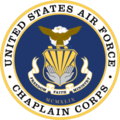Composition and leadership
The chair of the AFCB is a position rotated among the military departments, with one of the chief of chaplains of the military departments appointed as chair for a period of twelve months. [3] In addition, a senior military chaplain holding the rank of O-6 (Army or Air Force colonel or Navy captain) serves as the AFCB executive director for a three-year term. [3]
The board chair may establish ad hoc groups, as necessary, to conduct studies, assemble information, present recommendations, and otherwise assist the board in carrying out its responsibilities. Such groups will include at least one representative from each military department, nominated by the respective chief of chaplains. [3]
Emblem, USA Chaplain Corps
Emblem, USN Chaplain Corps
Emblem, USAF Chaplain Corps
Executive directors
The current executive director is: 2024 – Present: CH (COL) David Wake (Army); previously, 2021 – 2024: Ch, Col Dale Marlowe (Air Force); 2019 – 2021: CAPT William Riley, CHC (Navy); 2017 – 2019: CH (COL) Jay Johns (Army); 2015 – 2017: CAPT Jere Hinson, CHC (Navy); 2012 – 2015: Ch, Col Jerry Pitts (Air Force); 2011: CH (COL) Steve Moon (Army); 2009 – 2010: CH (COL) Thomas E. Preston (Army); 2006 – 2009: CAPT Jonathan Frusti, CHC (Navy); 2003 – 2006: Ch, Col Richard Hum (Air Force); 2000 – 2003: CH (COL) Janet Horton (Army); 1998 – 2000: CAPT Russ Gunter, CHC (Navy); 1997 – 1998: CAPT M.R. Ferguson, CHC (Navy); 1995 – 1996: Ch, Col Cecil Richardson (Air Force); 1994 – 1995: Ch, Col Lorraine Potter (Air Force); 1992 – 1994: CH (COL) Herman Keizer (Army); 1991 – 1992: CH (COL) Arthur Thomas (Army); 1989 – 1991: CH (COL) Meredith Standley (Army); 1986 – 1989: Ch, Col John Mann (Air Force); 1983 – 1986: CAPT Alan Plishker, CHC (Navy); 1980 – 1983: CH (COL) Harold Lamm (Army); 1977 – 1980: Ch, Col Samuel Powell (Air Force); 1974 – 1977: CAPT Alfred Saeger, CHC (Navy); 1972 – 1974: CH (COL) Duncan Stewart (Army); 1968 – 1971: Ch, Col, Hans Sandrock (Air Force); 1965 – 1968: CAPT Samuel Sobel, CHC (Navy); 1962 – 1965: CH (COL) John Rhea (Army); 1959 – 1962: Ch, Col William Clark (Air Force); 1957 – 1959: CAPT A.M. Oliver, CHC (Navy); 1956 – 1957: CH (COL) Edward Mize (Army); 1954 – 1955: Ch, Col Vernon Goodhand (Air Force); 1952 – 1954: CAPT Francis McGann, CHC (Navy)
This page is based on this
Wikipedia article Text is available under the
CC BY-SA 4.0 license; additional terms may apply.
Images, videos and audio are available under their respective licenses.









